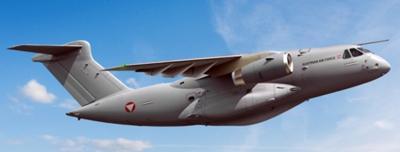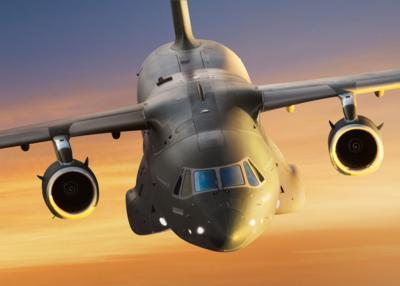Multi-Mission Platform to Serve as Austrian Military Transport Aircraft
The Austrian Ministry of Defense has selected Embraer’s C-390 Millennium aircraft as its new tactical transport solution. Austria joins Brazil, Portugal, Hungary, and the Netherlands as a future operator of Embraer’s increasingly popular multi-mission platform.

Embraer’s C-390 Millennium is a mid-sized utility transport aircraft of a conventional high-wing, twin-jet-engine, T-tail empennage design. The aircraft is kitted-out with an over-cockpit refueling-probe similar to that of Airbus’s A400M turboprop transport.
The C-390 is powered by a pair of 31,330-lbf. IAE V2500-E5 turbofan engines mounted forward of the aircraft’s high wing. So motivated, the aircraft manages a 533-knot (0.799 Mach) maximum speed, a 470-knot (0.70 Mach) cruise speed, and an unremarkable service-ceiling of FL360. The C-390’s 191,800-pound maximum takeoff weight comprises a 77,161-pound empty weight, a 57,320-pound payload, and a standard fuel capacity of 50,700-pounds.
Founded in 1983 for the express purpose of developing a turbine engine conducive to the needs of the 150-seat single-aisle aircraft market, International Aero Engines (IAE) is a Zürich-registered joint venture of Pratt & Whitney, Germany’s MTU Aero Engines AG, and the Japanese Aero Engine Corporation. The company’s V2500 turbofan engine is among the world’s most popular aircraft powerplants and can be found slung beneath the wings of Airbus’s A320 family.
To the subject of wings, Embraer provisioned the C-390 with an elegant and efficient high-main-wing featuring a conspicuous anhedral angle, slats, and high-lift devices capable of deploying to 40-degrees deflection. The design affords the C-390 a degree of agility rare in cargo aircraft and occasions excellent low-speed manners—to include a leisurely 104-knot Vso stall-speed.
The two, dual-axle main assemblies of the C-390’s undercarriage retract into bilateral sponsons affixed to the lower, underwing aspect of the aircraft’s fuselage. The single-axle nose-wheel is steerable via a flight-deck tiller. Tires are of the low-pressure (85-psi) variety. Collectively, the architecture facilitates operations from soft, unpaved ground, austere airstrips, and damaged runways.
The C-390’s two-pilot crew interface with the aircraft via dual active sidesticks commanding a fully fly-by-wire flight-control system. Power-management is by dint of a Full Authority Digital Engine Control (FADEC) scheme and autothrottles.
The C-390’s flight deck is handsomely appointed with Rockwell Collins’s Pro Line Fusion avionics suite, twin head-up displays, and enhanced vision. The aircraft’s Thales Group-supplied navigational system includes INS, GPS, and TCAS. The jet’s SELEX Galileo Gabbiano tactical radar is capable of Ground Moving-Target Indication (GMTI), Synthetic Aperture Radar (SAR), Inverse Synthetic Aperture Radar (ISAR), and Search And Rescue Radar Transponder (SART) modes.

By way of self-defense, the C-390 sports an Elbit Systems-supplied directional infrared countermeasures suite.
The C-390’s hold measures 61-feet in length, 11-feet-four-inches in width, nine-feet-eight-inches in height, and is accessed primarily via a large rear-ramp integrated with the aircraft’s aft-lower fuselage. The aircraft can be configured to perform missions the likes of troop, VIP, and cargo transportation, and aerial refueling (as a tanker). Fully-loaded, the C-390 can carry payloads such as two fully-tracked M113 armored personnel carriers, one Boxer armored vehicle, a Sikorsky H-60 helicopter, 74 litters with corresponding life-support equipment, up to eighty soldiers or 66 paratroopers in full gear. Loads of up to 42,000-pounds can be air dropped from the aircraft’s rear-door.
Since entering operation with the Brazilian Air Force in 2019, the C-390 has proven capable and reliable. The service’s current fleet of five aircraft—all in the KC-390 aerial refueling configuration—has accumulated north of 8,900-flight-hours with a mission-readiness rate of approximately eighty-percent and a mission-completion rate exceeding 99-percent.
 ANN's Daily Aero-Term (05.10.24): Takeoff Roll
ANN's Daily Aero-Term (05.10.24): Takeoff Roll Aero-News: Quote of the Day (05.10.24)
Aero-News: Quote of the Day (05.10.24) Airborne 05.06.24: Gone West-Dick Rutan, ICON BK Update, SpaceX EVA Suit
Airborne 05.06.24: Gone West-Dick Rutan, ICON BK Update, SpaceX EVA Suit Airborne 05.03.24: Advanced Powerplant Solutions, PRA Runway Woes, Drone Racing
Airborne 05.03.24: Advanced Powerplant Solutions, PRA Runway Woes, Drone Racing Aero-News: Quote of the Day (05.11.24)
Aero-News: Quote of the Day (05.11.24)




